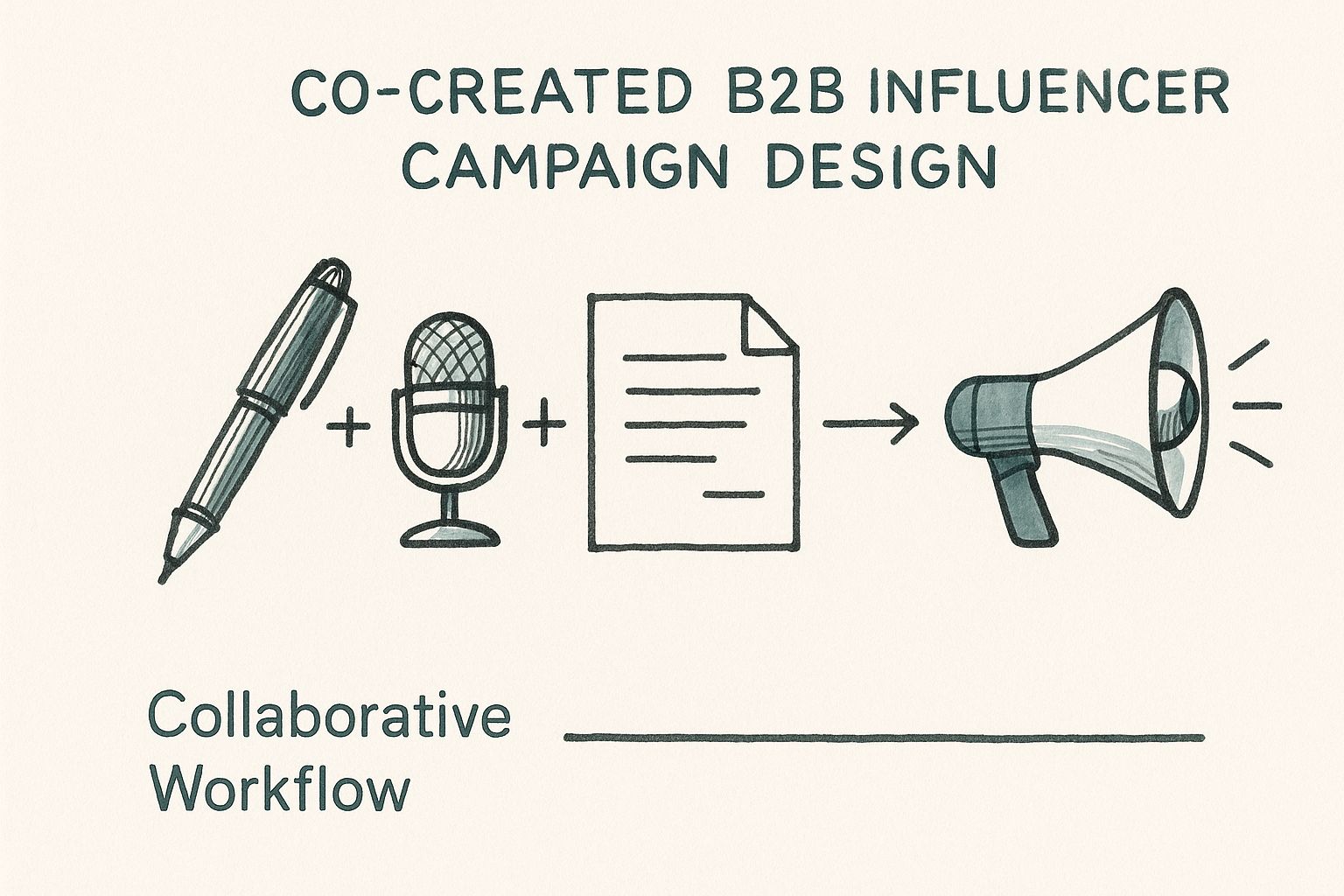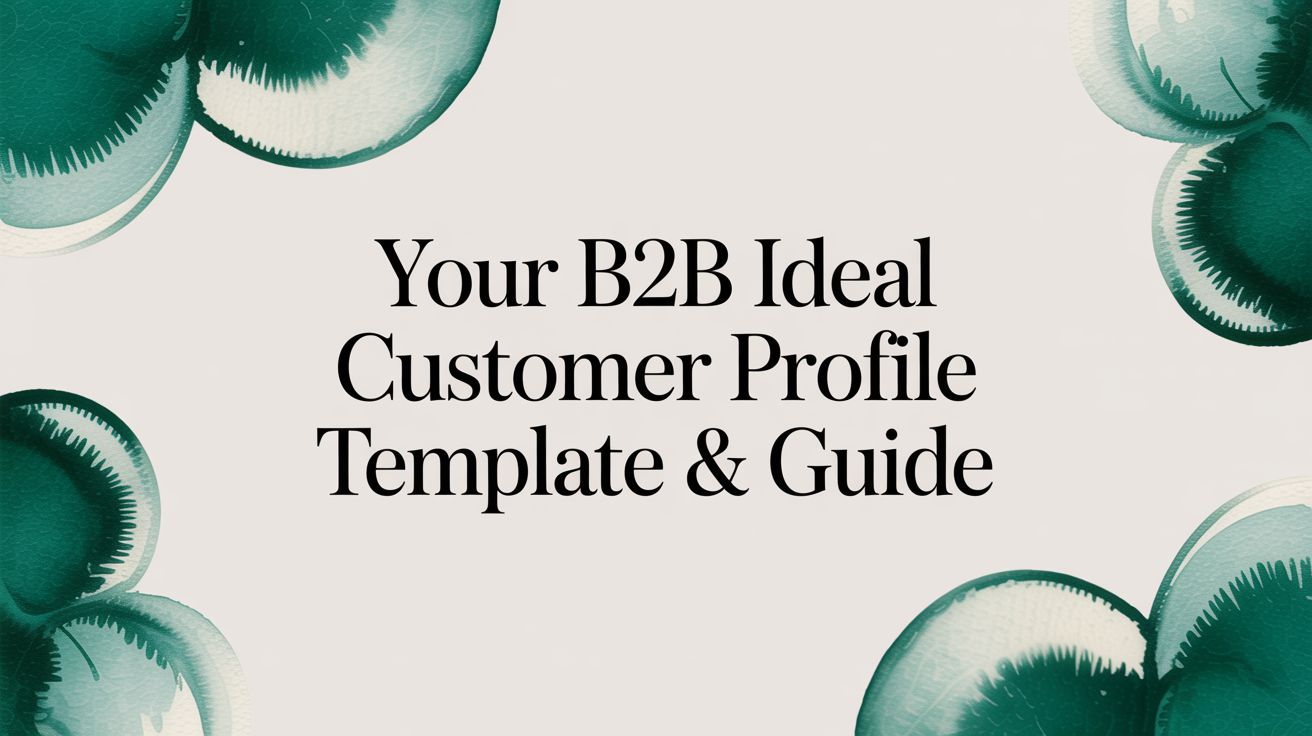B2B Influencer Marketing Done Right
October 21, 2025

Let's be honest, in a world drowning in corporate buzzwords and generic sales pitches, B2B influencer marketing isn't just another tactic—it's the only way to build real trust. It's about shifting your mindset from shouting advertisements at people to starting genuine conversations with them, guided by the experts they already listen to and admire. This is how you earn credibility, not just buy attention.
The New Currency of Trust in B2B

The old B2B marketing playbook is officially broken. For years, companies got by with a top-down approach, blasting out messages and just hoping something would stick. But today’s decision-makers are savvier, better informed, and far more skeptical of the hard sell.
They don’t want to be sold to; they want to be guided by people they believe in. This one shift has turned trust into the single most valuable asset a B2B company can have. Building it is no longer a happy accident—it has to be your core strategy. We explore this concept in-depth in our guide on how to build trust with B2B content marketing.
Why Credibility Is Your Greatest Asset
Think about the last time you made a major business purchase. Did a banner ad convince you? An unsolicited email? Of course not. You probably asked a respected colleague for advice, scoured reviews from industry peers, or followed the lead of an expert you trust.
Your customers are doing the exact same thing. They cut through the noise of a complex buying journey by looking for authentic signals of expertise and reliability. This is precisely where B2B influencer marketing shines.
It's not about celebrity endorsements or flashy social media posts. It's a strategic partnership with respected industry voices who have already earned the trust of your ideal customers.
These aren't transactional relationships. They're true collaborations built on shared knowledge and mutual respect. When an influencer offers their genuine endorsement, it acts as a powerful seal of approval for your brand, cutting through the clutter in a way no corporate brochure ever could.
A New Model for Authentic Connection
The numbers back this up. Heading into 2025, a solid 67% of B2B brands are already using influencer marketing to build brand awareness, and 54% are using it specifically to boost their credibility and trust. Even more telling, a staggering 99% of B2B marketers running continuous, always-on influencer programs call their efforts effective. You can dig into more of this data by checking out the latest influencer marketing statistics and findings.
This approach transforms your marketing from a one-way monologue into a dynamic conversation. Instead of shouting to be heard, you’re joining discussions that are already happening in the circles your audience values most. It’s a strategy built for the modern B2B world, where genuine connection—not just conversion—is what drives sustainable growth.
By partnering with the right experts, you don’t just reach an audience; you earn their confidence.
How Influencer Partnerships Drive Real Results

It’s one thing to talk about building trust and another to see how it actually produces business outcomes. So let's move past the theory and get into the tangible value B2B influencer marketing brings to the table. These partnerships aren't just about getting your name out there; they are serious growth engines.
Think of an influencer's endorsement as a trusted colleague's recommendation right when it matters most. It doesn't just get your foot in the door—it kicks it wide open.
This single act of validation cuts through the marketing noise, instantly positioning your brand as a credible solution instead of just another vendor shouting for attention. The result is a foundation of authenticity that can accelerate the entire buying process. Your brand goes from being an outsider to a valued insider in your industry's most important conversations.
Forging Deep Brand Credibility
The first and most immediate result is a massive injection of credibility. When a respected industry expert aligns with your brand, their hard-won reputation rubs off on you. This isn't something you can buy with a PPC campaign; it has to be earned through genuine association.
This "borrowed trust" is incredibly potent in the B2B world, where buying decisions are high-stakes and almost always made by a committee. A single piece of content co-created with a known expert can do more to build confidence than a dozen of your own case studies.
By aligning with respected voices, you don't just reach their audience—you inherit a measure of their authority. This validation is a shortcut to establishing your brand as a serious player in the field.
This credibility isn’t just a warm and fuzzy feeling; it has a direct impact on the bottom line. It shortens sales cycles because prospects show up with a baseline of trust already established. Your sales team can then spend their time solving problems instead of proving your brand is legit.
Reaching Elusive Niche Audiences
So many B2B companies hit a wall trying to connect with highly specific, often elusive, audiences. Think specialized engineers, data scientists, or C-suite executives in a niche vertical. These decision-makers are notoriously tough to reach with traditional marketing because they've become experts at filtering out generic corporate messages.
B2B influencers, however, have already done the heavy lifting of building engaged communities around these exact topics.
- Direct Access: They give you a direct line to the professionals you want to engage, speaking their language on the platforms they actually use.
- Qualified Attention: Their followers aren't just scrolling past; they are actively seeking expert insights and solutions, making them a highly receptive audience for your message.
- Authentic Engagement: The influencer acts as a trusted filter, presenting your brand in a context that resonates with their community's unique challenges and goals.
This kind of precision targeting eliminates wasted ad spend and ensures your message lands where it will have the most impact—right in front of the key decision-makers who can truly move the needle for your business.
Generating Highly Qualified Leads
At the end of the day, marketing has to contribute to revenue. This is where b2b influencer marketing truly proves its ROI by generating leads who are already warmed up for a real conversation.
When a lead comes through an influencer’s recommendation, they arrive with a completely different mindset. They aren't just "aware" of your brand; they're pre-qualified by the trust they have in the expert who sent them. This naturally leads to higher conversion rates and a much more efficient sales process.
To really understand this impact, you need to be tracking the right metrics from the start. You can learn more about setting this up in our guide on how to measure marketing effectiveness.
Finding the Right Industry Experts to Partner With
The entire success of your B2B influencer marketing hinges on one critical element: the quality of your partners. Finding the right experts isn't like casting for a commercial; it's more like recruiting a key member of your team. This requires a thoughtful, deliberate approach to make sure their expertise, audience, and values are a perfect match for yours.
Forget chasing the biggest names or the most impressive follower counts. The most powerful partnerships spring from a real, authentic connection with specialists who have earned genuine respect in your specific niche. Your job is to find the true subject matter experts, not just popular personalities.
Moving Beyond Follower Counts
In B2B, an influencer's audience size is often the least important metric. Instead, your focus needs to be on three core qualities: relevance, resonance, and reputation. A micro-influencer with 5,000 highly engaged followers who are all potential customers is infinitely more valuable than a general business guru with 100,000 disconnected followers.
To find these hidden gems, you have to look where your customers look for trusted information.
- Industry Publications and Podcasts: Who are the go-to contributors and regular guests on the shows your audience actually listens to?
- Conference Speaker Lists: Who is getting invited to share their knowledge at the most respected industry events?
- Professional Communities: Who are the active, helpful voices in niche LinkedIn Groups or specialized forums?
You can also get valuable leads for your outreach by researching lists of the most influential business speakers in different fields.
Vetting for True Expertise and Audience Fit
Once you’ve put together a list of potential partners, the real work begins. This is where you dig deep to confirm they are the right fit for your brand and your goals. It’s a make-or-break step that separates campaigns that soar from those that fall flat.
Start by digging into their content. Does their expertise genuinely line up with your product or service? Look for depth and original thinking, not just the same recycled industry talking points everyone else is sharing. An expert’s ability to break down complex ideas with clarity is a huge indicator of their authority.
Next, get to know their audience. Read the comments on their posts and listen to the questions people ask during their webinars. Are these the people you want to reach? High-quality engagement—think thoughtful questions and real discussions—is far more important than a high volume of likes. For a deeper look into this, check out our guide on how B2B marketing on LinkedIn can help you find where these conversations are happening.
The right B2B influencer doesn’t just have an audience; they have a dedicated community built on a foundation of proven expertise and shared professional interests. This is the community you want to join.
Crafting Outreach That Prioritizes Mutual Value
Your first message sets the tone for the entire relationship. Whatever you do, avoid generic, templated outreach. The best approach is always personalized, respectful of their time, and completely focused on creating value for both sides.
Before you even think about hitting "send," do your homework. Reference a specific piece of their work you genuinely admired—a recent article, a podcast episode, or a conference talk. This simple act proves you've done more than just glance at their profile and immediately separates you from the dozens of other requests they probably get.
Frame your proposal as a true collaboration, not just another transaction.
- Start with Their Expertise: Clearly explain why you believe their specific insights would be valuable for a joint project.
- Highlight Audience Benefit: Show how a partnership would provide genuine value to their community, not just promote your brand.
- Propose a Concrete Idea: Suggest a specific collaboration, like co-hosting a webinar on a shared topic or co-authoring an insightful research report.
- Be Flexible: Make it clear that you are open to their ideas and want to build something together that they can be proud of.
This collaborative mindset is absolutely key. By leading with respect and a clear vision for mutual benefit, you transform your outreach from a cold pitch into an inspiring invitation to create something truly great together.
Designing Your B2B Influencer Campaign
So, you’ve found the right experts to partner with. Now for the fun part: building the actual campaign.
This is where we move from a promising idea to a high-impact program that delivers real, measurable results. It’s all about designing an experience that creates genuine value for everyone involved—your brand, the influencer, and most importantly, their audience.
A successful campaign isn’t built on luck; it’s the result of sharp objectives, true collaboration, and smart distribution. Think of it less like handing over a script and more like co-writing a story that your audience will be genuinely excited to follow.
Setting Sharp and Measurable Objectives
Before you even think about content, you need to define what success actually looks like. Vague goals like “increasing brand awareness” just won’t cut it. Your objectives have to be specific, measurable, and tied directly to bigger business outcomes.
Start by asking the right questions. Are you trying to generate 500 qualified leads for a new product? Do you want to drive a 20% increase in demo requests this quarter? Or is the main goal to completely own the share of voice around a key industry topic?
Your objectives are the north star of your campaign. They guide every single decision you make, from the type of content you create to the channels you use to get it out there.
Once you have your primary goal, work backward to set clear Key Performance Indicators (KPIs). For a lead generation campaign, your KPIs might be webinar registrations or content downloads. For a thought leadership play, you might track social shares, brand mentions, and audience sentiment. This clarity is what turns a good idea into a great strategy.
Co-Creating Content That Delivers Real Value
The real magic of B2B influencer marketing happens when you create something together. This isn’t about giving an influencer a list of talking points and crossing your fingers. It’s about merging your brand’s core message with their unique insights and authentic voice to create something truly valuable for the audience.
This infographic paints a simple picture of how this collaborative creation works, blending different forms of expertise into one powerful message.

Think of it as the fusion of an influencer’s expert voice (the microphone) and your brand’s strategic input (the pen). The result is a powerful, co-owned asset that actually connects with the people you’re trying to reach.
The key here is to give your expert partner creative freedom. They built their community by being themselves, and trying to script them will only kill the campaign’s authenticity. Instead, work with them to brainstorm ideas that serve their audience first.
A few ideas to get you started:
- Webinars: Host a live discussion where the influencer shares their expertise on a pressing industry problem—one that your product just happens to help solve.
- White Papers or E-books: Co-author a deep-dive piece of research that combines their industry knowledge with your company's proprietary data.
- Podcast Series: Create a limited-run series where the influencer interviews your internal experts or customers about a critical topic.
The goal is to create content that feels like a natural extension of the influencer’s own brand, not a thinly veiled ad for yours. When you get this right, the final product is authentic, insightful, and incredibly effective.
Selecting and Activating Distribution Channels
Creating amazing content is only half the battle. If no one sees it, it doesn’t matter how good it is. You need a thoughtful distribution plan to make sure it reaches the right people at the right time.
This is another area where your collaboration with the influencer is absolutely crucial. Start with their primary channels—the places where their audience is already listening. But don’t stop there. Amplify the content across multiple platforms to maximize its reach and impact. You can get some powerful ideas from our guide to multi-channel marketing campaign examples.
To help you get started, it's useful to think in terms of established campaign models. Each one is built to achieve a different kind of goal.
B2B Influencer Campaign Models and Applications
The table below breaks down a few common campaign structures. Use it to match your primary goal with the right model, keeping in mind the typical time commitment for each.
Choosing the right model and distribution channels ensures that your carefully crafted message not only lands but also inspires action. This strategic approach is what turns your influencer partnership from a one-off tactic into a powerful and predictable engine for business growth.
Measuring Success and Proving ROI to Stakeholders
An inspiring B2B influencer campaign is just a nice story if you can’t prove it worked. If you want to secure future budgets and earn the trust of your leadership team, you’ve got to connect your efforts directly to business results.
This means moving past simple vanity metrics and focusing on what actually moves the needle for the company's bottom line. The goal is to build a clear, data-backed narrative that transforms your influencer program from a marketing "expense" into a strategic growth driver.
Moving Beyond Surface-Level Metrics
Likes and shares are easy to count, but they rarely tell the whole story in a B2B context. A single, high-quality lead from a C-suite executive is infinitely more valuable than a thousand clicks from an irrelevant audience.
To prove real impact, your key performance indicators (KPIs) have to be tied directly to sales outcomes and long-term business goals.
The most powerful ROI story isn't just about reach; it's about revenue. It’s about demonstrating how an influencer partnership directly contributed to filling the sales pipeline with qualified opportunities.
Think of it like this: vanity metrics are the smoke, but business-focused KPIs are the fire. You need to show leadership the fire. This requires a much more thoughtful approach to measurement—one that tracks the customer journey from that first touchpoint all the way to a closed deal.
Key B2B Influencer Marketing KPIs
To build your ROI case, you need to concentrate on the metrics that directly reflect business impact. These KPIs provide a clear line of sight from your campaign activities to meaningful results, giving you the hard data you need to justify your investment and sharpen your strategy.
Focus your reporting around these core areas:
- Lead Quality and Conversion: Go beyond the raw number of leads. Track how many of those leads converted into Marketing Qualified Leads (MQLs) or Sales Qualified Leads (SQLs). Did leads that came from influencer channels close faster or at a higher rate than those from other sources?
- Pipeline Influence: Use UTM parameters and dedicated landing pages to track how many opportunities in your sales pipeline were touched by the influencer campaign. You can often show that these partnerships influenced deals even if they weren't the initial source of the lead.
- Share of Voice (SOV): Measure how your brand's presence in relevant industry conversations has grown compared to your direct competitors. This metric shows how you are becoming a more dominant and respected voice in your market.
When you're measuring success, understanding metrics like Customer Acquisition Cost (CAC) is a game-changer. Showing that your influencer program brings in high-value customers more efficiently than other channels is a powerful argument. For a deeper dive, check out our guide on how to calculate customer acquisition cost.
Presenting Your Findings to Leadership
How you present your data is just as important as the data itself. Don't just dump a spreadsheet full of numbers on your stakeholders. Instead, weave your findings into a clear and compelling story that connects the dots between your campaign and the company's success.
The global influencer marketing market is projected to hit $32.55 billion by 2025, with over 80% of marketers confirming it's a highly effective strategy. In the B2B world, the focus is on depth, with 47% of marketers prioritizing long-term influencer partnerships that build sustained value. You can explore more data on this trend by reading the latest influencer marketing benchmark report.
Start your presentation with the big picture: restate the campaign's original business goals. Then, present your key findings with clear visuals, showing exactly how you met or exceeded those goals. Most importantly, conclude with actionable insights and your recommendations for what to do next. This positions you not just as a marketer running a campaign, but as a strategic leader driving measurable growth.
Have Questions About B2B Influencer Marketing?
As you start thinking about putting B2B influencer marketing into practice, it’s completely normal for some real-world questions to pop up. This last section is all about tackling the most common ones I hear, from getting the budget approved to making this work in super-specialized fields.
Think of this as your practical guide for turning a great idea into a program that actually drives growth. Let's get into the questions that often stand between a smart concept and a powerful reality.
How Do I Justify the Budget for B2B Influencer Marketing?
How you frame the budget request is everything. This isn't just another line item for marketing; it's a strategic investment in credibility, trust, and generating high-quality leads. You have to speak the language of business outcomes, not just marketing tasks.
A great place to start is by benchmarking against what you're already doing. Put the potential cost-per-lead from an influencer campaign right next to what you’re spending on paid search or social ads. This simple comparison immediately puts your request in terms the CFO will understand.
Present compelling data that shows how influencer-generated content builds trust far more effectively than traditional branded content. Emphasize its long-term value; a co-authored white paper or webinar recording can generate leads for months or even years.
To make your case even stronger, propose a pilot program with a tight scope and crystal-clear goals. For example, you could aim to generate a specific number of qualified leads from a single webinar co-hosted with a respected industry expert.
By tracking everything—referral traffic from the influencer’s channels, conversion rates on your landing page, even how quickly these specific leads move through your sales cycle—you build an undeniable case. This data-driven approach shows real ROI and makes it much easier to ask for a bigger investment down the road.
What Are the Biggest Mistakes to Avoid in B2B?
So many of the common slip-ups in B2B influencer marketing come from a single, fundamental error: treating it like a B2C campaign. B2B decisions are driven by logic, expertise, and trust—not hype.
The first mistake is getting distracted by big follower counts instead of focusing on audience relevance and genuine expertise. In the B2B world, a niche expert with 5,000 highly engaged followers in your specific industry is infinitely more valuable than a general business guru with 100,000 casual followers.
Another huge mistake is being too controlling with the content. These B2B influencers have spent years building their reputations on their unique insights and authentic voice. If you force them to read a corporate script, you'll instantly destroy their credibility and poison the entire campaign.
Finally, try to avoid one-off, transactional projects. The real power of B2B influencer marketing comes from building genuine, long-term relationships. When an influencer goes from being a project partner to a true brand advocate, their ongoing endorsement becomes one of your company's most valuable assets.
Can This Work for Highly Technical or Niche Industries?
Absolutely. In fact, it's often one of the most effective strategies you can use in highly technical or specialized fields where trust and expertise are everything. In these markets, your target decision-makers are incredibly skeptical of traditional marketing and have finely tuned filters for corporate-speak.
The key is to find the true subject matter experts—the engineers, data scientists, analysts, or specialized consultants who are deeply respected by their peers. These are the real influencers in their communities.
You might not find them on the usual social media platforms. Their influence is often concentrated in other places:
- Specialized Forums: They could be the most helpful and respected voices in niche online forums or professional communities.
- Academic Circles: Their reputation might be built on published research and academic papers.
- Niche Conferences: They're often the go-to speakers at industry-specific events that your audience flocks to.
Partnering with these experts to co-create deeply technical content is a complete game-changer. Imagine co-authoring an in-depth white paper on a complex engineering problem or hosting a technical webinar that dives into the real-world nuances of a new technology.
These collaborations lend your brand immense credibility and open doors to conversations that advertising never could. You're not just reaching an audience; you're earning the respect of a community.
Ready to build a B2B marketing strategy that drives real growth? At Big Moves Marketing, I specialize in helping B2B SaaS and AI startups launch new products with positioning and sales tools that secure adoption and revenue. Let's build your go-to-market plan together.
%20-%20Alternate.svg)


%20-%20white.svg)